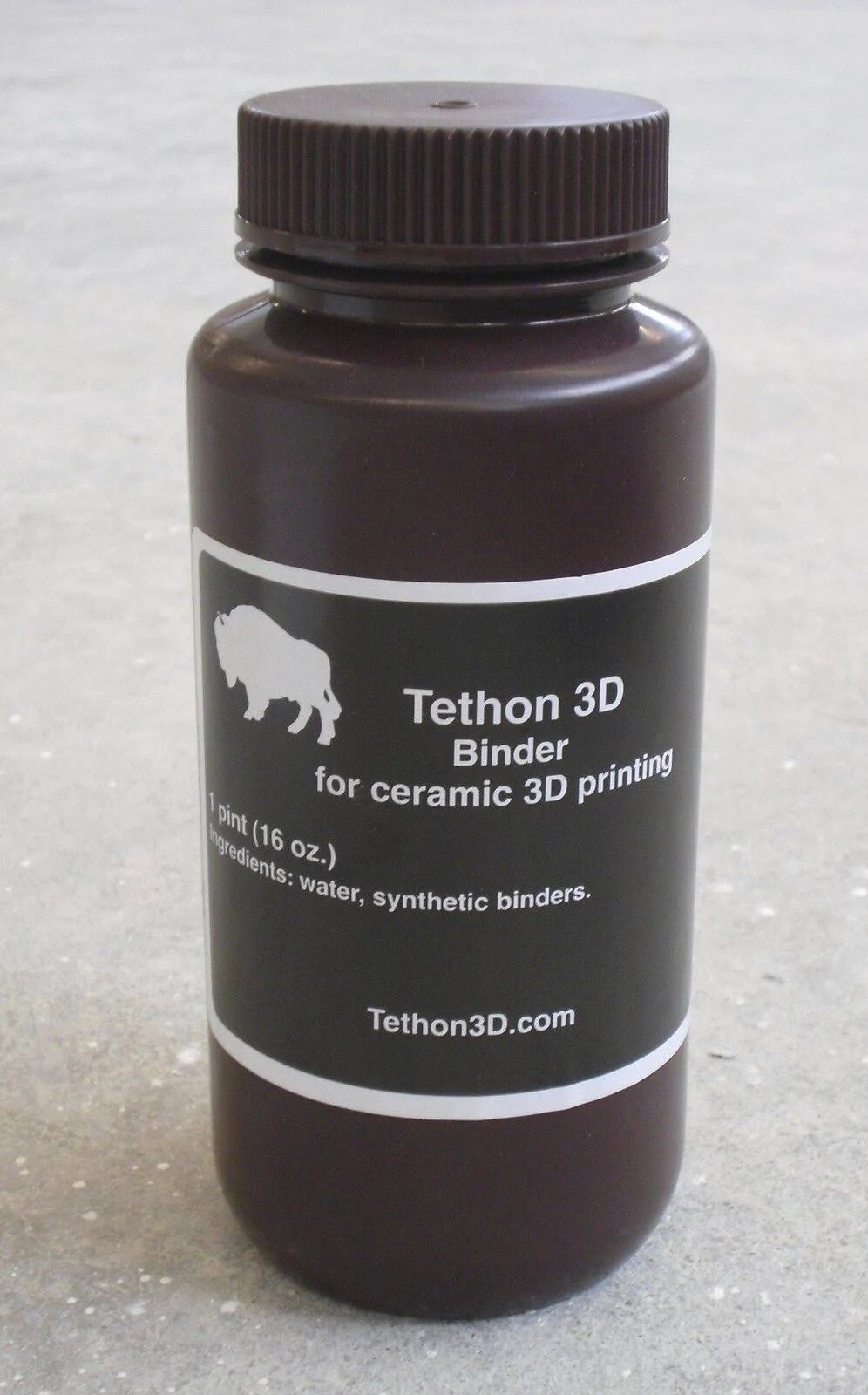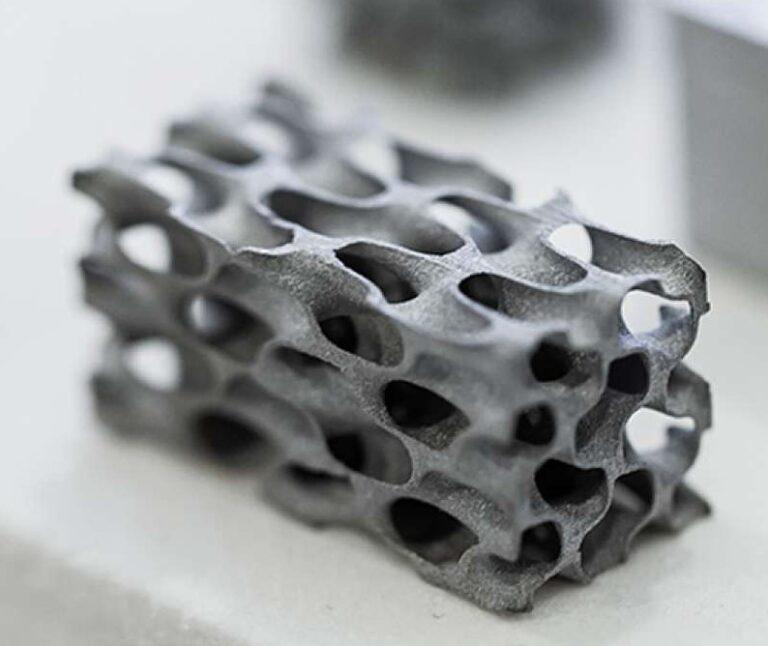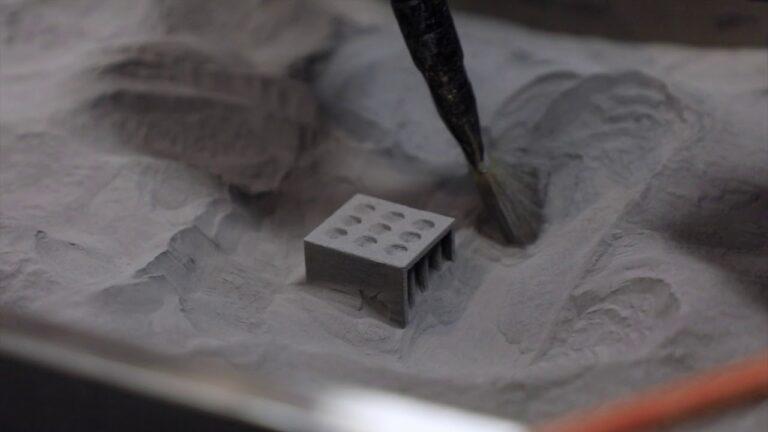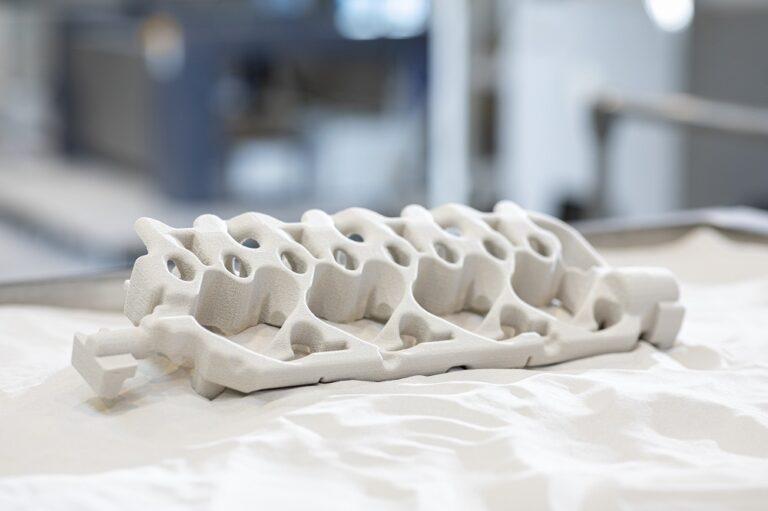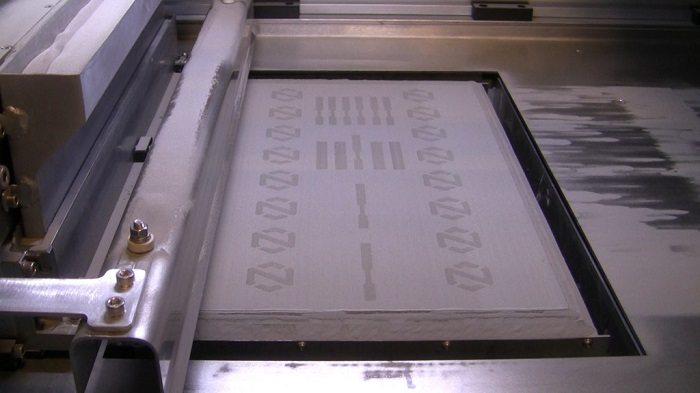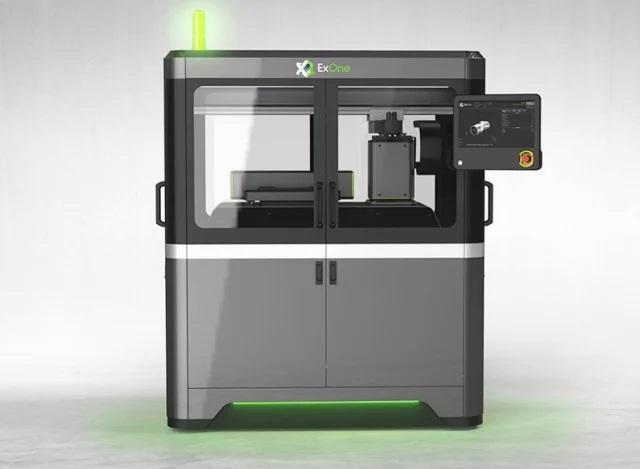Introduction to Binder Jetting 3D Printing Technology
Binder Jetting is a groundbreaking additive manufacturing technique that has revolutionized the world of 3D printing. Dr. Ely Sachs and Dr. Michael Cima invented this technology in the early 1990s at MIT. Since then, it has evolved and expanded its capabilities.
In essence, Binder Jetting creates solid parts layer by layer by selectively depositing binders onto a powder bed. The process starts by spreading a thin layer of powder material, like metal or ceramic, on the build platform. A printhead then applies the binder to specific powder areas, bonding particles and providing structural integrity. The platform lowers, adds new powder layers, and repeats the process until completing the part. Finally, they remove the excess powder and perform post-processing to achieve the final properties.
In this blog, we explore Binders for Binder Jetting, covering different topics for a comprehensive understanding of the technology. We will explore the different types of binders available, as well as their key properties and selection criteria. We’ll discuss binder compatibility with different materials in Binder Jetting and address environmental and health considerations.
We will explore the latest advancements and innovations in binders for Binder Jetting. This includes new materials, formulations, and smart binders that push 3D printing boundaries.
We will explore the future outlook and challenges for Binders in Binder Jetting. This includes upcoming trends, research directions, and potential barriers to adoption. Join us on this exciting journey as we unlock the full potential of Binder Jetting. Discover the transformative 3D printing technology of Binders for Binder Jetting.
The Crucial Role of Binders in Binder Jetting
Binders are crucial in Binder Jetting 3D printing, holding printed parts together and impacting the process’s success. In this section, we’ll discuss the significance of binders and their impact on Binder Jetting’s overall success.
First and foremost, binders provide structural integrity to the printed parts. The printhead deposits binder onto the powder bed, adhering particles and forming the shape layer by layer. Without the binders, the powder particles would remain loose, making it impossible to create a coherent structure.
The binder choice can impact mechanical properties like strength, durability, and wear resistance of the final part. Different binders offer varying degrees of adhesion and bonding strength, which directly influence the performance of the printed parts. Therefore, selecting the appropriate binder for a specific material and application is crucial.
In addition to mechanical properties, binders also impact the surface finish of printed parts. A well-chosen binder will enable a smooth surface finish, minimizing the need for extensive post-processing. Surface finish is crucial for intricate and complex parts with detailed geometries. It poses challenges.
The drying and curing rates of binders are crucial for printing. Optimal times maintain part shape and prevent distortion, ensuring precise dimensions and high-quality prints. Additionally, binder compatibility with various materials, such as metal, ceramic, or polymer, is crucial in Binder Jetting. The right binder must adhere well to the chosen powder; otherwise, poor adhesion may result in weak or brittle parts.
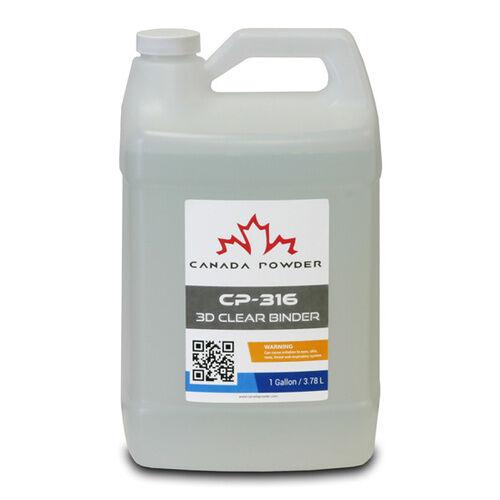
Types of Binders for Binder Jetting
Choosing the correct binder is vital for Binder Jetting, impacting part quality and properties. In this section, we will discuss various types of binders for Binder Jetting and their unique characteristics.
Water-based binders
Initially, water-based binders are a popular choice due to their eco-friendliness and low cost. These binders typically contain a combination of water, polymers, and additives, providing good adhesion and mechanical properties. However, they may require a longer drying time, which could affect the overall printing speed.
some examples of water-based or aqueous binders
Here are some examples of water-based or aqueous binders used in Binder Jetting, along with their general characteristics:
- Polyvinylpyrrolidone (PVP): In Binder Jetting, people commonly use PVP as a water-soluble polymer binder. It offers excellent film-forming and adhesive properties and is compatible with various powder materials, including metals, ceramics, and polymers.
- Polyethylene glycol (PEG): In Binder Jetting processes, people widely use PEG as a binder, which is another water-soluble polymer. It has good binding and lubricating properties, making it suitable for use with a range of powder materials. Manufacturers often use PEG in combination with other binders to enhance the overall performance of the binder system.
- Carboxymethyl cellulose (CMC): CMC is a cellulose derivative that is soluble in water and has good film-forming and adhesive properties. It is biodegradable and environmentally friendly, making it an ideal choice for applications that require non-toxic, biocompatible, or biodegradable components.
- Sodium alginate: Sodium alginate is a natural, water-soluble polysaccharide derived from brown seaweed. It has excellent film-forming and adhesive properties, and its biodegradable nature makes it suitable for applications that require eco-friendly binders.
- Maltodextrin: Derived from starch, maltodextrin is a water-soluble carbohydrate that serves as a binder in Binder Jetting. It’s good adhesion and film-forming properties make it a commonly used option. It is biodegradable and non-toxic, making it suitable for applications where environmental concerns are essential.
These are just a few examples of water-based binders used in Binder Jetting. Different binders have unique properties, catering to specific applications and desired part characteristics, based on powder material.
Advantages of water-based or aqueous binders
- Environmentally friendly: Water-based binders have lower VOC emissions and are more eco-friendly, reducing environmental impact.
- Lower flammability: Water-based binders are less flammable, enhancing safety during handling and storage compared to solvent-based binders.
- Easier cleanup: Water-based binders are easy to clean and rinsed away with water, and no harsh chemicals are needed.
- Reduced odors: Water-based binders typically have less odor than solvent-based binders, making them more pleasant to work with in enclosed spaces.
- Non-toxic: Many water-based binders are non-toxic and safer for users and the environment.
Disadvantages of water-based or aqueous binders
- Slower drying times: Water-based binders typically have longer drying times compared to solvent-based binders, which can result in a slower overall printing process.
- Moisture sensitivity: Water-based binders are more susceptible to moisture absorption, which can negatively affect the performance and stability of the printed parts, especially in humid environments.
- Lower adhesion strength: Water-based binders might exhibit lower adhesion strength compared to solvent-based binders, leading to weaker parts or requiring additional post-processing steps to achieve the desired strength.
- Freezing concerns: Water-based binders can freeze at low temperatures, which may impact their storage, handling, and performance during the printing process.
- Limited compatibility: Water-based binders may not be compatible with certain powder materials, such as hydrophobic powders, which can affect the quality and performance of the final parts.
- Potential for microbial growth: Water-based binders may be more prone to microbial growth, which can lead to spoilage or contamination if not properly stored or handled.
Manufacturers can make informed decisions by understanding disadvantages of water-based or water-soluble binders. Factors like drying time, material compatibility, and environmental conditions are considered in binder selection for Binder Jetting.
Applications of water-based or aqueous binders
- Ceramic and metal parts: In Binder Jetting, manufacturers often use water-based binders to produce ceramic and metal parts that demand high dimensional accuracy and fine detail.
- Sand molds and cores: Manufacturers use water-based binders in sand mold and core production for eco-friendly casting applications. These binders provide better environmental performance than traditional alternatives.
- Architectural models: Water-based binders are suitable for creating architectural models that require high precision and complex geometries.
- Biomedical applications: Due to their biocompatibility and lower toxicity, manufacturers can use water-based binders in biomedical applications, such as producing implants or prosthetics.
- Artistic creations: Water-based binders are suitable for creating artistic pieces with intricate details and high-quality surface finishes.
Organic/Inorganic binders
On the other hand, solvent-based binders offer faster drying times and improved mechanical properties compared to water-based binders. They often contain organic solvents that help dissolve the binder components, enabling better penetration into the powder particles. However, these binders may be costly and raise environmental and health concerns by employing volatile organic compounds (VOCs).
Organic and inorganic binders each offer unique advantages and applications in the Binder Jetting process. Here are some examples:
Organic Binders
some examples of Organic Binders
- Polyvinyl alcohol (PVA): In Binder Jetting, people widely use PVA as an organic binder, especially for ceramic and metal powders. Its excellent film-forming and adhesive properties make it suitable for producing parts with good strength and dimensional stability.
- Cellulose-based binders: Derived from plant materials, cellulose-based binders, such as carboxymethyl cellulose (CMC) and hydroxypropyl cellulose (HPC), are biodegradable and environmentally friendly. Binder Jetting frequently utilizes them for applications that necessitate non-toxic, biocompatible, or biodegradable components.
- Acrylic binders: Organic binders, which are based on acrylic polymers, exhibit excellent adhesion and flexibility. Industries frequently utilize them in Binder Jetting for polymer and metal parts that demand improved mechanical properties and resistance to environmental factors.
Organic and inorganic binders each offer specific advantages and applications in the Binder Jetting process. Here’s an overview of their benefits and uses:
Advantages of Organic Binders
- Flexibility: Organic binders generally provide greater flexibility, resulting in parts that are less prone to cracking or breaking under stress.
- Biodegradability: Organic binders derived from natural sources make them biodegradable and environmentally friendly.
- Compatibility: Organic binders often demonstrate good compatibility with a wide range of powder materials, including metals, ceramics, and polymers.
- Adhesion: Organic binders typically have strong adhesive properties, leading to parts with excellent structural integrity and strength.
Disadvantages of Organic Binders
- Lower temperature resistance: Organic binders generally have a lower resistance to high temperatures compared to inorganic binders, limiting their use in high-temperature applications.
- Potential for degradation: Some organic binders may degrade or decompose over time due to exposure to chemicals, moisture, or UV radiation, potentially affecting the part’s long-term performance.
- Flammability: Certain organic binders can be flammable, posing potential safety concerns during processing or in the final application.
Applications of Organic Binders
- Biomedical: Due to their biocompatibility, organic binders find frequent use in biomedical applications, such as the creation of implantable devices or tissue scaffolds.
- Consumer products: Organic binders are suitable for manufacturing various consumer products, including toys, packaging materials, and kitchenware, due to their non-toxic nature.
- Electronics: In Binder Jetting processes, companies use organic binders to create electronic components or devices due to their ability to provide good adhesion and dimensional stability.
Inorganic Binders
some examples of Inorganic Binders
- Silicate-based binders: In Binder Jetting, particularly for sand-casting molds and cores, people use sodium silicate and potassium silicate as examples of inorganic binders. They provide excellent high-temperature resistance and are suitable for applications that involve high heat exposure, such as automotive and aerospace components.
- Phosphate-based binders: In Binder Jetting for ceramics and metal parts, we use binders that contain phosphates, such as ammonium or magnesium phosphates. They provide strong chemical bonding, resulting in parts with enhanced mechanical properties and high dimensional accuracy.
- Alumina-based binders: In Binder Jetting processes that require high-temperature resistance and enhanced mechanical strength, we use binders that contain alumina, such as aluminum oxyhydroxide, for ceramic and metal parts. These binders are particularly suitable for applications in industries like electronics, aerospace, and automotive.
Advantages of Inorganic Binders
- High-temperature resistance: Inorganic binders generally exhibit excellent resistance to high temperatures, making them ideal for applications that involve heat exposure.
- Chemical stability: Inorganic binders have good chemical stability, leading to parts with consistent properties and resistance to chemical degradation.
- High strength: Parts created using inorganic binders often exhibit high mechanical strength and dimensional accuracy.
Disadvantages of Inorganic Binders
- Brittleness: Inorganic binders can lead to more brittle parts compared to organic binders, making them more susceptible to cracking or breaking under stress or impact.
- Limited compatibility: Inorganic binders may have limited compatibility with certain powder materials or might require specific processing conditions to achieve optimal results.
- Environmental impact: Some inorganic binders may have a higher environmental impact due to their non-biodegradable nature or the resources required for their production.
Applications of Inorganic Binders
- Sand casting: Binder Jetting commonly uses inorganic binders, such as silicate-based binders, to create sand-casting molds and cores due to their excellent high-temperature resistance.
- Ceramics: Manufacturers use inorganic binders like alumina or phosphate-based binders for producing ceramic parts due to their ability to offer strong chemical bonding and high dimensional accuracy.
- Automotive and aerospace: Manufacturers use inorganic binders to produce components for the automotive and aerospace industries, as they provide high strength and temperature resistance, which are crucial for these demanding applications.
Understanding the benefits of organic and inorganic binders helps manufacturers select the right one for Binder Jetting. This ensures high-quality and high-performance parts.
Reactive binders
Additionally, reactive binders are another option in Binder Jetting. These binders consist of components that react with the powder material during the printing process, forming strong chemical bonds. This type of binder can result in parts with superior mechanical properties and dimensional accuracy. However, they may require a more complex curing process and could be limited to specific materials.
some examples of Reactive binders
Reactive binders are those that undergo chemical reactions to solidify and bind the powder particles together during or after the Binder Jetting process. Here are some examples of reactive binders:
- Resorcinol-Formaldehyde (RF) binders: RF binders are used in the production of ceramic parts and provide high green strength and excellent sintering properties. The resorcinol-formaldehyde resin undergoes a polymerization reaction during curing, forming a strong bond between the powder particles.
- Silicate binders: These binders are used for sand casting applications and work by reacting with a hardener, such as an ester or an acid, to form a solid, chemically bonded structure. The reaction between the silicate binder and the hardener creates a strong bond between the sand particles, forming the mold or core.
- Polyurethane binders: In Binder Jetting, polyurethane binders are used for sand casting applications. They react with a hardener, typically an isocyanate, to form a solid, durable structure. This reaction results in strong adhesion between the sand particles and forms a mold or core suitable for casting.
- Alumina-based binders: These binders are used in the production of ceramic parts and involve a chemical reaction between the binder and the powder material. The alumina-based binder reacts with the ceramic powder to create a strong bond, providing high green strength and excellent sintering properties.
Manufacturers can select suitable reactive binders for Binder Jetting by considering factors like material compatibility, required strength, and post-processing properties. Understanding the available binders is crucial for making informed choices in specific applications.
Advantages of Reactive binders
- High strength: Reactive binders often provide higher green strength and mechanical properties due to the chemical reactions that occur during the binding process. This results in stronger printed parts and improved performance in demanding applications.
- Better dimensional stability: Reactive binders can offer improved dimensional stability during the printing and post-processing stages, as they create strong chemical bonds between the powder particles, reducing part deformation or shrinkage.
- Tailorable properties: Formulators can create reactive binders to achieve specific properties or performance characteristics, such as hardness, flexibility, or resistance to heat, chemicals, or moisture. This allows for customization of printed parts to meet the requirements of various applications.
- Compatibility with a wide range of materials: Reactive binders can be used with various powder materials, such as metals, ceramics, and sands, making them versatile in their application across different industries.
- Reduced post-processing requirements: Due to the chemical reactions that occur during the binding process, reactive binders can sometimes minimize the need for additional post-processing steps, such as sintering or curing, which can save time and resources.
Manufacturers consider advantages of reactive binders for Binder Jetting process. They make informed decisions on binder selection. Factors include material compatibility, desired properties, and performance requirements.
Disadvantages of Reactive binders
- Complexity in handling: Reactive binders often require careful handling and storage due to their sensitivity to environmental conditions, such as temperature, humidity, and exposure to specific chemicals or reactants. This can increase the complexity of the printing process and the need for controlled environments.
- Potentially hazardous: Some reactive binders involve chemicals or reactions that can be hazardous, posing potential health and safety risks to workers if not managed properly. Proper handling, storage, and disposal procedures must be followed to ensure safety.
- Limited shelf life: Due to their reactive nature, these binders may have a limited shelf life compared to non-reactive binders. Manufacturers need to closely monitor and manage their inventory to prevent spoilage or wastage of materials.
- Longer processing times: Reactive binders may require additional processing time, as the chemical reactions involved in the binding process could take longer than the drying or curing times of non-reactive binders.
- Cost: Reactive binders can be more expensive than non-reactive binders due to their specialized formulations and the need for additional processing equipment or controlled environments.
Manufacturers weigh reactive binders’ disadvantages against advantages to assess suitability for Binder Jetting. They consider potential drawbacks, application requirements, and specific process needs for decision-making.
Applications of Reactive binders
- Metal components: Reactive binders are often used in the production of complex metal parts for industries such as aerospace, automotive, and medical. The strong chemical bonds formed by these binders allow for high-strength and durable components.
- Ceramic parts: In the manufacturing of advanced ceramic components, reactive binders can help produce parts with enhanced mechanical properties, thermal resistance, and chemical stability. These parts find applications in electronics, energy, and biomedical industries.
- Sand casting cores and molds: Reactive binders are widely used in the creation of sand cores and molds for metal casting processes. The high strength and dimensional stability provided by these binders enable the production of intricate and precise castings.
- Rapid prototyping: Reactive binders can be used in rapid prototyping applications to create functional and durable prototypes that closely resemble the final product’s properties. This enables efficient design iterations and testing before full-scale production.
- Biomedical implants: In the field of biomedical engineering, reactive binders can be utilized to produce customized implants, such as dental crowns, orthopedic implants, and tissue scaffolds. These binders can be tailored to provide the desired mechanical properties and biocompatibility for the specific application.
- Energy storage devices: Reactive binders play a role in the fabrication of energy storage devices, such as batteries and fuel cells, by ensuring strong adhesion between the active materials and current collectors, resulting in improved performance and durability.
Manufacturers understand applications of reactive binders. They select appropriate binders for Binder Jetting based on industry requirements.
Hybrid binders
Lastly, hybrid binders combine the advantages of different binder types to optimize performance. Hybrid binders combine polymers, solvents, and reactive agents to achieve enhanced adhesion and mechanical properties. They offer compatibility with diverse materials through component blending.
some examples of Hybrid binders
Hybrid binders combine the properties of two or more different types of binders, aiming to achieve optimal performance characteristics for specific applications. Some examples of hybrid binders include:
- Acrylic-silicone hybrid binders: These combine the flexibility and adhesion properties of acrylic binders with the weather resistance and durability of silicone binders. They are often used in exterior coatings, such as paints and sealants.
- Epoxy-polyurethane hybrid binders: By combining the excellent adhesion and chemical resistance of epoxy resins with the flexibility and impact resistance of polyurethane binders, these hybrids can be used in applications such as automotive coatings and industrial floorings.
- Polyvinyl alcohol (PVA)-starch hybrid binders: These hybrids offer a combination of the water solubility and biodegradability of PVA with the low cost and renewable nature of starch. They are often used in paper coatings and adhesives.
- Inorganic-organic hybrid binders: These binders combine the mechanical strength and thermal stability of inorganic binders with the flexibility and processability of organic binders. They can be used in applications such as advanced ceramics and high-temperature-resistant coatings.
These are just a few examples of hybrid binders used in various applications. The specific formulation and properties of a hybrid binder will depend on the desired performance characteristics and end-user requirements.
Advantages of Hybrid Binders
- Improved performance: By combining the beneficial properties of different binders, hybrid binders can offer enhanced performance characteristics that may not be achievable with a single binder type. This can result in improved mechanical properties, chemical resistance, or durability, depending on the specific hybrid formulation.
- Versatility: Hybrid binders can be customized to suit a wide range of applications by altering the ratio and combination of binder components. This enables manufacturers to tailor the binder’s properties to meet specific industry and end-use requirements.
- Balanced properties: Hybrid binders can address the limitations of individual binders by providing a balance between their strengths and weaknesses. For example, a hybrid binder can combine the flexibility of one binder with the strength of another to create a material with both properties.
- Enhanced processability: The combination of binders in a hybrid formulation can result in improved processability, such as easier mixing, spreading, or curing. This can lead to more efficient manufacturing processes and reduced production costs.
- Environmental benefits: Hybrid binders can incorporate environmentally friendly components, such as bio-based or biodegradable materials, to reduce the environmental impact of the binder and the final product. This can be an important consideration for manufacturers looking to improve the sustainability of their products.
By understanding the advantages of hybrid binders, manufacturers can make informed decisions about the appropriate binder choice for their specific Binder Jetting process and end-use applications.
Disadvantages of Hybrid Binders
- Complexity: The formulation of hybrid binders can be more complex than that of single-component binders, as it involves the careful selection and combination of multiple binder types. This can require additional research, development, and testing efforts to achieve the desired properties and performance.
- Cost: Due to the combination of multiple binder types, hybrid binders can be more expensive than their single-component counterparts. The increased cost may result from the use of specialized materials, additional processing steps, or higher research and development expenses.
- Compatibility issues: The mixing of different binder types can sometimes lead to compatibility issues, such as phase separation or reduced adhesion between the binder components. These issues may require additional additives or process modifications to address and maintain the desired performance characteristics.
- Limited availability: Hybrid binders are often specialized formulations tailored for specific applications, which may not be readily available in the market. This can make it challenging to source these materials or find suitable alternatives for a particular application.
- Potential trade-offs: While hybrid binders offer a balance of properties, they may not always provide the best performance in every aspect. In some cases, using a hybrid binder may involve a trade-off between different properties, such as strength and flexibility, or chemical resistance and processability.
Despite these disadvantages, hybrid binders can still offer significant benefits for certain applications. Manufacturers must carefully consider the potential drawbacks and evaluate whether a hybrid binder is the optimal choice for their specific needs and requirements.
Applications of Hybrid Binders
- Aerospace and automotive industries: Hybrid binders can provide enhanced mechanical properties and lightweight materials, making them suitable for aerospace and automotive components, such as engine parts, structural components, and lightweight panels.
- Medical devices: The combination of biocompatibility, strength, and flexibility offered by some hybrid binders makes them suitable for medical devices, such as implants, prosthetics, and surgical tools.
- Electronics: Hybrid binders can be formulated to provide improved electrical conductivity, thermal stability, and chemical resistance, which are essential properties for electronic components, such as circuit boards and sensors.
- Construction materials: Hybrid binders can offer enhanced durability, strength, and resistance to environmental factors, making them suitable for various construction materials, such as concrete, bricks, and composite materials.
- Energy storage: Hybrid binders can improve the performance of energy storage devices, such as batteries and fuel cells, by providing enhanced conductivity, stability, and durability.
- Art and cultural heritage restoration: Hybrid binders can be used in the restoration of artwork and cultural heritage items due to their customizable properties, such as flexibility, adhesion, and compatibility with various substrates.
- Consumer products: Hybrid binders can be utilized in various consumer products, including sports equipment, furniture, and packaging materials, where a combination of strength, flexibility, and aesthetics is required.
- Additive manufacturing: In Binder Jetting 3D printing, hybrid binders can offer a balance between strength, processability, and compatibility with different materials, enabling the production of complex and high-quality parts.
Hybrid binders exhibit versatility for diverse industries and products, adapting to specific requirements. Manufacturers optimize materials by selecting and combining binder components, enhancing properties for various applications.
part two
In this comprehensive guide to binders for Binder Jetting, we have explored the essential role of binders in the 3D printing process, discussed the different types of binders available, including water-based, organic/inorganic, reactive, and hybrid binders, and examined their advantages, disadvantages, and applications.
As we have discovered, binders play a crucial role in determining the strength, durability, and overall quality of printed parts. Selecting the right binder is critical to achieving the desired performance and properties of the final product.
To further our understanding of binders for Binder Jetting, we will continue this discussion in Part Two of this blog post, where we will delve into the key properties and selection criteria for binders, such as viscosity, drying and curing rates, compatibility with the powder material, and mechanical properties. We will also explore common Binder Jetting materials and their compatible binders, environmental and health considerations, advancements and innovations in binder technology, and the future outlook and challenges for binders in Binder Jetting.
Stay tuned for Part Two, where we will provide valuable insights and knowledge to help you make informed decisions when selecting binders for your Binder Jetting projects.
How to select the right binder for binder jetting based on material compatibility?
- Identify Material Requirements
Determine the specific material requirements for your binder jetting project, such as the type of material (metal, ceramic, polymer, etc.) and any specific characteristics or properties needed.
- Research Binder Options
Conduct thorough research on available binders that are compatible with the desired material. Explore binder formulations, properties, and manufacturers to gather relevant information.
- Evaluate Material-Binder Compatibility
Assess the compatibility between the selected materials and binders. Consider factors such as chemical interactions, adhesion properties, and compatibility with the printing process.
- Review Technical Data
Collect binder data (viscosity, solid content, curing temperature) and specifications. Verify alignment with material and printing goals.
- Consult Manufacturers or Experts
Seek advice and consultation from binder manufacturers or experts in the field. They can provide valuable insights, recommendations, and guidance based on their expertise and experience.
- Perform Compatibility Tests
Conduct small-scale tests to evaluate the compatibility between the selected binder and material. This step helps identify any potential issues or limitations and ensures successful binder integration.
- Consider Process Requirements
Take into account the specific requirements of the binder jetting process, such as equipment compatibility, drying and curing methods, and post-processing considerations. Ensure the selected binder aligns with these process requirements
- Make an Informed Decision
Based on the gathered information, compatibility tests, and consideration of process requirements, make an informed decision on the most suitable binder for your binder jetting project.
- Monitor and Optimize
Continuously monitor the performance of the selected binder during the binder jetting process. Optimize parameters as needed, such as binder concentration, mixing ratios, or curing conditions, to achieve desired results.
- Adapt to New Materials
As new materials and binders become available, stay updated with advancements in the field. Adapt the binder selection process to accommodate emerging materials and their specific compatibility requirements.
FAQs
Some key properties to consider include viscosity, drying and curing rates, compatibility with the powder material, and mechanical properties. Each property can significantly impact the quality and performance of the printed parts.
Yes, ongoing research and development efforts are focused on improving binder formulations, optimizing printing parameters, and exploring new binder materials. These advancements aim to enhance print resolution, material compatibility, and overall process efficiency.
Challenges in adopting binder jetting technology include optimizing process parameters, achieving consistent part quality, and addressing the limitations in material options and post-processing techniques. Continuous advancements and research aim to overcome these challenges and expand the applications of binder jetting.
Yes, binder jetting is a versatile technology that can be used with various materials, including metals, ceramics, polymers, and even sand. Different binders and processing parameters are used to accommodate specific material requirements.
The choice of binder can significantly impact the final properties of the printed parts. It affects factors such as strength, dimensional accuracy, surface finish, and post-processing requirements. Selecting the appropriate binder is essential to achieve the desired characteristics for the intended application.

